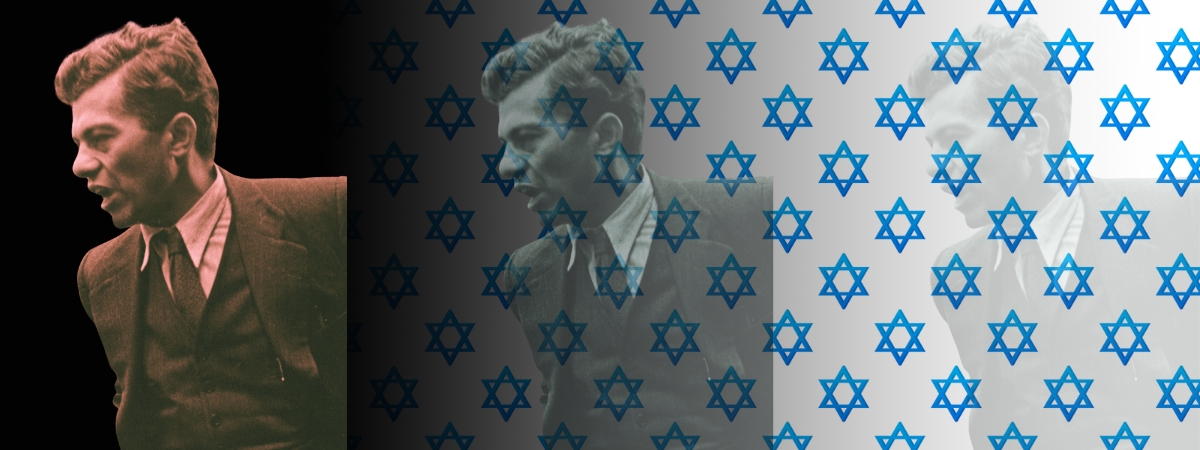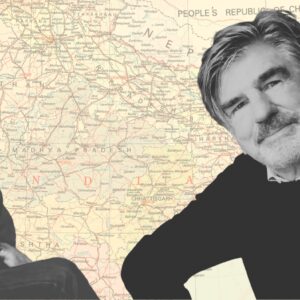
On the Decades-Long Erasure of Jewish Working-Class Anti-Zionism
Benjamin Balthaser on Mike Gold, Alexander Bittelman, and the Paradoxes of Left-Wing Zionism
There is a scene in Mike Gold’s 1930 novel Jews Without Money that links the many strands of left-wing Jewish identity formation to political Zionism at mid-century. Mikey, the novel’s narrator and proletarian icon for the “red decade” of the 1930s, travels with his father, Herman, to the outer suburbs of Brooklyn to buy what his father hopes will be a suburban dream house.
Herman, a Romanian Jewish house painter, has been offered the house through his associations with the “Zionist leader” and “big dry goods merchant” Baruch Goldfarb—a man Herman believes will rescue him from a life of poverty. Herman joins a gaudy Jewish lodge, full of ritual and costume, and pays substantial dues to Goldfarb’s burial association, even when Goldfarb ignores Herman’s repeated requests for a loan to restart his tailoring shop.
Believing that his association with wealthy Jews is his ticket to success, Herman becomes friendly with an associate of Goldfarb’s, a real estate agent, and agrees to move his family to the suburbs where he imagines he will no longer be an “East Side beggar.”
While this scene is Jews without Money’s lone comment on Zionism, it’s worth pausing to consider what Gold’s sly intervention on the topic suggests about his view of Jewish colonialism in mandate Palestine. Goldfarb is introduced as “a Zionist leader” who not only cheats Herman out of his money through his burial association, but also inducts Herman into the reactionary political formation of his lodge: organizing vote rigging, labor spies, and the alignment of Jewish workers with the interests of the Jewish bourgeoisie.
That Zionism is further associated with Herman’s desire to move out to the suburbs is also telling: Mikey’s class-conscious mother wants to remain on the multiethnic Chrystie Street rather than move to the isolated and assimilationist suburbs. “God’s country” of the suburbs—a not-so-subtle dig at God’s country of Zion—is associated not only with bourgeois con men, but also with whiteness, assimilationism, and class betrayal.
From a contemporary perspective, what is most remarkable about Gold’s anti-Zionist subplot is not the prominence of the author, but that Gold assumed it did not need explanation.
Ultimately, Herman’s acts as a labor spy for Goldfarb’s associate, Mr. Cohen, can be read as a tragic just deserts, as Herman pitches to his near death from a faulty catwalk at Mr. Cohen’s worksite that might have been fixed had a union been allowed to organize. It should be noted that Herman’s dreams of middle-class success in an isolated Jewish enclave away from the racially mixed, transnational pressures and pleasures of urban life are also what finally kill him.
Does Zionism kill Herman? No, but the racial and economic formation out of which Zionism arises does. From a contemporary perspective, what is most remarkable about Gold’s anti-Zionist subplot is not the prominence of the author, but that Gold assumed it did not need explanation.
Mike Gold, born Itzok “Irwin” Granich, was perhaps the foremost practitioner and promoter of the proletarian literary movement in the US. As a founding editor of the leading left-wing arts journal during the Popular Front, the New Masses, Gold became the cultural arbiter of literary taste for the Communist Party USA (CPUSA), pugnaciously denouncing both high modernism and middlebrow literature alike.
And to say Gold was merely a novelist is something of an understatement: as Alan Wald and others have noted, “creative literary practice” took precedence over other forms of cultural output for those in the Communist orbit. For Gold to denounce Zionism in such terms, as both the editor of the most prestigious socialist arts journal of the era and the most popular Jewish literary figure of the Popular Front era, suggests that it is more than just the idle opinion of a lone eccentric.
For Gold’s Jewish readers, the idea that a “Zionist leader” is a petty bourgeois scammer who ensnares gullible working-class house painters into his utopian schemes would be immediately recognizable, part of the left-wing common sense of the era.
Criticism of Zionism was common on the Jewish left in the 1930s and 1940s, so common that a historian of Zionist cultural literature could find only one left-wing Jewish author, Meyer Levin, who took up pro- Zionist themes (and his novels were widely panned).
As Yuri Slezkine writes, of the three Jewish “Promised Lands” of the twentieth century, citizenship in the United States, immigration to Israel, and the Bolshevik Revolution (that is, assimilation, nationalism, or Communism), Communism remained by far the most popular solution to the “Jewish question” in the decades between the wars.
Or as writer and Communist Party critic Robert Gessner put it bluntly in New Masses, “In America, about one percent of America’s Jews are Zionist.” Derided as nationalists, imperialists, and the petty bourgeoisie, Zionists were a small and often-mocked minority within the Jewish socialist left, so much so a recently revived Yiddish song ridicules Zionists as “little” and “foolish,” out of touch with “the workers’ reality.”
While there has never not been an anti-Zionist Jewish left, that Zionists could be referred to as small-minded idiots, relegated to the ash heap of history, is clearly a sentiment one must regard—in our current conjuncture—with wonder.
The erasure of this left-wing, working-class, anti-Zionist common sense can not only be laid at the feet of Israel and its defenders. Or rather, its erasure is complex and, as with Mike Gold’s prescient trip to the suburbs, part of a larger ideological and material project that included an incomplete but nonetheless wide incorporation of immigrant Jewish life into dominant American ideas of race, politics, and identity.
As Bernard Lazare observed, Jewish history has been written by bourgeois historians for a bourgeois readership—radical Jews, especially working-class radical Jews, rarely figure much in historiography that locates Jewish life in religious institutions and well-funded advocacy agencies such as B’nai B’rith or the Anti-Defamation League (ADL).
The Communist Party and other smaller socialist and Trotskyist organizations have been under-examined as major sites of Jewish identity formation. It is, for instance, seldom appreciated that the Communist Party witnessed more Jews move through its ranks in the 1930s than the liberal American Jewish Committee (AJC) or more explicitly anti-Zionist Reform movement’s American Council for Judaism (ACJ), let alone organizations such as the ADL.
Indeed, throughout the 1930s, it is estimated that half of the CPUSA membership was Jewish, nearly all of eastern European, or Ashkenazi, descent, and given the rapid turnover of members, it may have amounted to as many as a few hundred thousand Jewish members over the decade, or perhaps as much as five to ten percent of the entire Jewish population.
That is to say, Communism should not only be considered something many Jews participated in, but as a subjective site in which Ashkenazi Jews made and remade their identities as often first- and second-generation Americans.
But rather than examine Jewish anti-Zionism through a lens of Jewish exceptionalism, I would suggest that Jews in the Communist Party orbit, like other non Anglo-Saxon “oppressed nationalities” in Alexander Bittelman’s framing of the time, strove to adopt a racialized framework of otherness that identified a Jewish subjectivity in solidarity with oppressed people of color, whether in the US or under colonial rule.
As Michael Denning, Robin Kelley, and Bill Mullen have argued, ethnic identification became the language of international class solidarity, rather than its antithesis, during the period of the radical midcentury left. In Michael Denning’s articulation of Stuart Hall’s famous phrase, “Ethnicity and race had become the modality through which working class peoples experienced their lives and mapped their communities.”
“Throughout the era of the British mandate in Palestine, the international communist movement regarded Zionism as a settler-colonial movement expropriating the rights of the indigenous population in alliance with British imperialism,” writes historian Joel Beinin.
For the most part, local Communist Parties followed the Soviet Union, which up until it supported Partition in 1947, either sided with Palestinian anti-colonial revolts or at least was ambiguous enough so that local and national Communist Parties often went their own way. Until 1947, the CPUSA and other radical left-wing groups in the US opposed Zionism as an imperialist project, chartered by the Balfour Declaration, directly or indirectly requiring the support of the British Empire.
Calling this diasporic, non-national character of an ethnically defined people “progressive Jewish culture,” Bittelman concludes that it is only through socialism—not nationalism—that Jews may finally live in their home countries in peace.
“Palestine is a colony of British imperialism,” CPUSA General Secretary Earl Browder said in an address on Zionism in the New York Hippodrome in 1936, “and no matter how deplorable present attacks on the Jews in Palestine are there is a rising revolutionary movement of the oppressed people fighting for its national independence.”
Browder was clear to separate pogroms against Jews in Poland and other parts of Europe from Arab attacks on Jewish settlers—the former he compared to the “Ku Klux Klan and the now infamous ‘Black Legion'” in the United States, while the latter he offered was resistance to “British imperialism by the Arab masses.”
In other words, while Jews may have been an “oppressed nationality” in Europe, in Palestine, the recent immigrants were part of an imperial project. The Communist Party also made clear that Zionism would require the “forcible expropriation of almost a quarter of a million Arabs.” While prescient, the statement was a drastic undercount.
And as most other left-wing parties throughout the world, Communists also opposed Zionism on the grounds that it was right-wing nationalism, an abandonment of both the class struggle inside Europe as well as joint Jewish and Arab struggles against imperialism in the Middle East. Zionists, as Gessner wrote in a 1935 essay, “The Brown Shirts of Zion,” were “Nazis”: an imperialist ethno-nationalism.
It would be tempting to suggest that left-wing Jewish anti-Zionism in this period was just an extension of Communist Party policy on the question of Palestine and that Jews in the CPUSA’s orbit just fell into line. Jewish anti-Zionism at mid-century, while perhaps “common sense,” was far more complex a formation.
Liberal critics of Zionism in the ACJ such as Reform Rabbi Elmer Berger often expressed their attacks on Zionism from an assimilationist perspective, worrying that Zionism would imply “dual loyalty” among US Jews and cut Jews off from mainstream American life. Berger and others in the ACJ circle also expressed a profound unease with the politics of ethnic belonging they felt were particular to secular Zionism, expressing that Jews were not “a nation” and had no common cultural or collective identity beyond a shared religious faith.
For the largest left-wing Jewish organization in prewar Europe, the Bund, or the General Jewish Labor Union of Eastern Europe, dual loyalty was not the issue: Zionism’s “separatist, chauvinist, clerical, and conservative” culture was understood as the “polar opposite” of the radical Yiddish-speaking organizations of Europe that were progressive, secular, and internationalist.
Even Trotsky, who was no fan of the Bund’s cultural separatism, lauded the union insofar as it
demanded full rights for the Jews where they lived and worked and fiercely opposed Zionism as a utopian, reactionary scheme, a form of self-expulsion, preached by Jewish bourgeois nationalists who played into the hands of anti-Semites and further divided the working class.
Despite differences with the Bund, Jewish Communists and socialists in the US constructed an ethnic particularism that echoed some of the Bund’s own cultural politics. As one historian suggests, Jewish socialists articulated their own politics of “nonassimilation” through, rather than despite, their attachment to the left.
For US Jewish radicals, the culture of the left became a way to separate themselves from what they understood to be a bourgeois, Anglo-Saxon, Christian-dominated American culture, while also avoiding the right-wing nationalism of Zionism. “The most radical Jews [in the Communist Party] tended to be the most insular,” a historian offered, and they created an ethnically separate Jewish world inside the party, through radical Jewish journals and party organizations.
Morgen Freiheit, the CPUSA-affiliated Yiddish-language newspaper, along with other Communist-affiliated publications and organizations such as Yidburo and the Organization for Jewish Colonization in Russia (known by its transliterated acronym ICOR) formed a kind of subculture on the left, devoted to Communism and articulating a particular modality of secular, socialist Jewish existence, of which Mike Gold was very much a part.
For Jewish socialists, Communism was the opposite of Browder’s slogan regarding the Popular Front: Communism was not twentieth-century Americanism so much as it was twentieth-century Judaism.
Perhaps one of the leading, if now unknown, theorists of Jewish life in the Communist Party was Alexander Bittelman, editor of the Communist Party’s theoretical journal, the Communist, and on the editorial board of the Communist-affiliated magazine Jewish Life. Bittelman wrote extensively about Jewish identity formation in a series of treatises distributed by the Communist Party, as well as in editorials and articles for Jewish Life and other left-wing Jewish publications.
Bittelman was a Russian immigrant who arrived in the US in the 1920s, worked for a time in the mid-1930s in Moscow writing anti-colonial party literature, and often mixed Jewish identity with Marxism in surprising ways, including his attempt to merge the cultural nationalism of the Bund with the CPUSA’s analysis of colonial nationalism, or writing, for instance, that his journey through the Suez Canal to the Soviet Union was “reliving the story of exodus.”
Bittelman’s position on Jewish identity should be placed in contrast not only to the liberal ACJ’s formulation that Judaism is just another religion, but also to the secular notion of “peoplehood” as articulated by Jewish studies scholar Noam Pianko. Pianko offers that Jews assimilated into the fabric of American life under the “ethnicity paradigm”—that all ethnic and racial groups could express cultural differences under a formal regime of legal equality.
Bittelman, however, approached the question of race and Jewish identity from a Marxian perspective of colonialism and national self-determination. Unlike Pianko, whose “ethnicity paradigm” tended to flatten differences in power between disempowered racialized groups, Bittelman offered an intersectional, Marxian framework to understand the ways in which capitalism structures race both nationally and globally.
Bittelman begins by offering a portrait of global capitalism and the ways it produces not only immiseration by class, but also “oppressed nations” such as “Porto Rico” (sic) and “the Philippines” as well as “geographical colonialism” by “economic and political pressure and intimidation.” These external colonies are reproduced internally as a “system of national discrimination” in the United States, a “peculiar system of oppression of peoples usually spoken of as minorities.”
It’s clear that Bittelman is trying to move the reader away from normative democratic explanations of racism—through either an “ethnicity paradigm” or questions of personal intolerance. Rather, Bittelman argues “the white ruling classes have established a regime of naked and brutal oppression in the so-called ‘Black Belt,'” where African Americans form “a nation” and suffer “national discrimination” throughout the rest of the country.
He continues that “Mexicans and Porto Ricans [sic]… occupy a special position in the American system of national discrimination” due to their countries’ colonial relationship to the United States. And finally he places Jews with “other various national groups such as Poles, Russians, Ukrainians” which are not “separate nationalities” but still face discrimination in terms of their class and from the “so-called superior Anglo-Saxon race.”
What, for Bittelman, all these groups have in common is that they face exploitation by a racialized form of capitalism, “imperialism…the most reactionary circles of finance capital.”
Jewish Americans, for Bittelman, are not an “oppressed nation,” even if unlike other European “national groups” they share a “community…large numbers have a common language, Yiddish, and…the struggle against anti-Semitism.” As Jewish oppression is not “colonial,” Bittelman refused to see the Yishuv as a national liberation project.
Bittelman observes, “Our people is made up of various communities with differing forms of national existence,” and he lists the Soviet Yiddish-speaking oblast of Birobidzhan, Soviet citizens of different republics, the Yishuv, and the United States. “This does not negate the existence of a Jewish people with common national characteristics and tasks but…each Jewish community has its own special problems and tasks determined by the conditions of the country in which it lives.”
Calling this diasporic, non-national character of an ethnically defined people “progressive Jewish culture,” Bittelman concludes that it is only through socialism—not nationalism—that Jews may finally live in their home countries in peace.
___________________________

Citizens of the Whole World: Anti-Zionism and the Cultures of the American Jewish Left by Benjamin Balthaser is available via Verso.
Benjamin Balthaser
Benjamin Balthaser's critical and creative work explores the connections among radical U.S. social movements, racial and class formation, internationalism, and culture. He is the author of Citizens of the Whole World: Anti-Zionism and the Cultures of the American Jewish Left (Verso, 2025), Anti-Imperialist Modernism: Race and Radical Transnational Culture from the Great Depression to the Cold War (University of Michigan Press, 2016) and Dedication (Partisan Press, 2011). His work has appeared or is forthcoming in journals such as American Quarterly, Historical Materialism, Boston Review, Jacobin, Shofar and elsewhere. He is currently associate professor of multi-ethnic U.S. literature at Indiana University, South Bend, and associate editor of American Quarterly.












